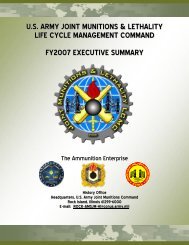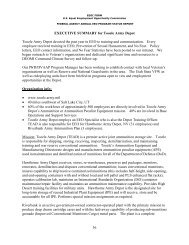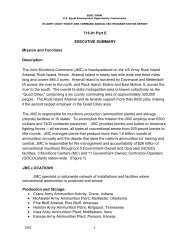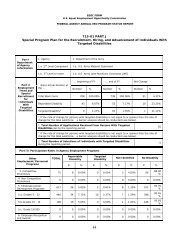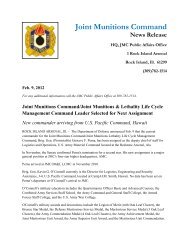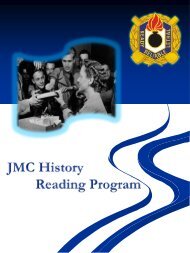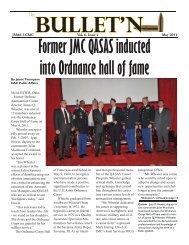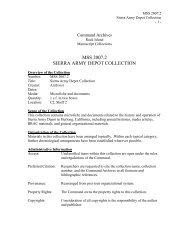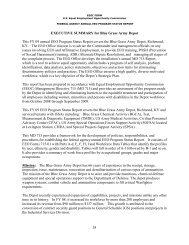History of the Ammunition Industrial Base - JMC - U.S. Army
History of the Ammunition Industrial Base - JMC - U.S. Army
History of the Ammunition Industrial Base - JMC - U.S. Army
You also want an ePaper? Increase the reach of your titles
YUMPU automatically turns print PDFs into web optimized ePapers that Google loves.
1951 <strong>the</strong> plants produced 50K tons <strong>of</strong> ammunition and by 1953 production had increased to<br />
165K tons. 104<br />
31 Dec 1951 30 Nov 1952 30 June 1953<br />
OAC Production 301 302 302<br />
Lines<br />
Lines Operated 94 118 141<br />
Standby Lines 207 184 161<br />
Tons <strong>of</strong> Ammo<br />
Produced<br />
50,000 90,000 165,000<br />
The production lines represented <strong>the</strong> capacity to reproduce a balanced variety <strong>of</strong> ammunition<br />
items equivalent to 55% <strong>of</strong> <strong>the</strong> peak capacity during WWII. Rehabilitation <strong>of</strong> standby lines<br />
began at many plants in 1951. In 1951 over 150 end items were in production but producers<br />
utilized many <strong>of</strong> <strong>the</strong> metal parts and components that were produced during WWII. 105<br />
During Korea <strong>the</strong> small arms base had been reduced from 12 WWII operating<br />
installations down to Twin Cities and Lake City, which could be augmented by potential<br />
contractor facilities <strong>of</strong> Winchester, Remington, and Western Cartridge commercial plants if<br />
required. In <strong>the</strong> course <strong>of</strong> planning for emergency production <strong>of</strong> small arms ammunition would<br />
require additional capability and <strong>the</strong> Ordnance Corps planned to later reactivate <strong>the</strong> St. Louis<br />
Ordnance Plant to supplement production. Changes in ammunition day <strong>of</strong> supply figures for<br />
small arms increased from 3 to 5 rounds for .30 caliber rifles and from 90 to 100 rounds for .30<br />
caliber machine guns between August 1950 and November 1952 106<br />
Minor caliber requirements established during mobilization planning never materialized<br />
and <strong>the</strong> available facilities were planned for utilization to accomplish o<strong>the</strong>r production functions<br />
such as renovation and demilitarization, assembling gas shells and grenades, and loading tracers<br />
and fuses. Most <strong>of</strong> <strong>the</strong> minor caliber lines had been built and equipped for interchangeable<br />
loading. Requirements as <strong>of</strong> July 1951 indicated that <strong>the</strong> use for which <strong>the</strong>y were intended<br />
would be limited to <strong>the</strong> production <strong>of</strong> 20mm ammunition, as no requirements existed for 40mm<br />
ammunition and <strong>the</strong> sole requirement for 27mm ammunition could be fulfilled by extensive<br />
rehabilitation, including <strong>the</strong> washout and reload <strong>of</strong> shells currently in stock. 107<br />
The total 20mm ammunition requirement assigned to <strong>the</strong> Ordnance <strong>Ammunition</strong> Center<br />
by <strong>the</strong> Ordnance Small Arms <strong>Ammunition</strong> Center was scheduled for <strong>the</strong> Kingsbury Ordnance<br />
Plant. Around 10% <strong>of</strong> <strong>the</strong> capacity was utilized but requirements forecasted 75% capacity would<br />
be required. Ogden Arsenal was assigned <strong>the</strong> responsibility for reloading and assembling 37mm<br />
rounds and began production in December 1950. There were two primary factors which affected<br />
<strong>the</strong> existing surplus capacity in minor caliber ammunition lines. The first was that <strong>the</strong> lines were<br />
originally designed for hand labor and relatively simple production. Automatic loading and<br />
assembly equipment efficiency increased 100% since WWII. The second reason was that small<br />
caliber requirements anticipated in mobilization planning for which potential production capacity<br />
104 Office <strong>of</strong> <strong>the</strong> Comptroller, Ordnance <strong>Ammunition</strong> Command. “A Review <strong>of</strong> <strong>the</strong> Ordnance <strong>Ammunition</strong> Center<br />
Current Mission, Functions and Responsibilities.” 1952.<br />
105 Ordnance <strong>Ammunition</strong> Command (OAC) Annual Command <strong>History</strong> 1951, 9-10. Reeder, 3.<br />
106 Snodgrass, 57-62.<br />
107 OAC Annual Command <strong>History</strong>, 1951, 50-55.<br />
35



